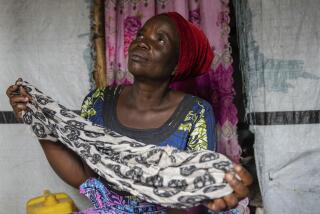Help for Healers : W. Los Angeles Team Aids Care Givers Traumatized by Hurricane’s Toll
Even the experts are shaken by disaster.
Mory B. Framer has been experiencing mild symptoms of post-traumatic stress disorder since he visited South Carolina in the days after Hurricane Hugo. “I’m still having images of trees snapped in half,” said the Westside psychologist, who went to Charleston to teach local counselors and therapists how to deal with the emotional aftermath of the devastating storm.
Framer is clinical director of Barrington Psychiatric Center in West Los Angeles, whose 26 psychiatrists, psychologists and other therapists specialize in treating the victims of natural disasters and other catastrophes. According to Framer, at least 90% of the victims of killer storms and other disasters experience one or more of the symptoms of post-traumatic stress disorder, the psychological affliction most commonly identified with troubled Vietnam War veterans.
These symptoms, he said, can include everything from flashbacks, nightmares, anger, shame, irritability and emotional numbness to loss of sexual drive and cold-like symptoms. Just knowing that such symptoms are a predictable part of the disaster experience helps victims recover, Framer said.
Framer said his firm was invited to South Carolina to work with the staff of the Medical University of South Carolina. Their job was to help equip mental-health workers for the emotional cleanup necessitated by Hurricane Hugo, which killed at least 18 people and left an estimated 70,000 homeless and many thousands more without jobs.
“What was so fascinating was that, due to the enormity and scope of that disaster, the people entrusted with mental-health care were suffering the same consequences of the disaster as everyone else,” Framer said. “We’re not immune.”
Framer said he and his colleagues gave the mental-health workers the advice they give all disaster victims. First, they educated them as to what to expect, including feelings of being out of control or feelings of guilt at having survived. “If you know what to expect, it helps you to normalize the reaction,” Framer said, adding, “It doesn’t take away the pain.”
The mental-health workers were told that the healing process would take time and not to have heroic expectations for themselves. “People hold themselves to an unreasonably high standard,” said Raymond J. Friedman, Barrington’s medical director who was also part of the Charleston team. “People feel that after a day or two they should feel much better.”
The mental-health workers were urged not to bottle up their feelings and to talk about their own reactions to the storm. They couldn’t stop doing so. Barrington staffer Jan Friedman, who also went to Charleston, noted that the closer she got to the storm-ravaged area, the more she heard people talking with great sadness about trees, one of the treasures Hugo had destroyed. “Everyone was literally mourning the trees,” she said.
Helpful Tips
The Barrington team advised the mental-health workers to seek additional help if their symptoms got worse. They also counseled the counselors to watch their diets, get plenty of exercise and to maintain familiar routines. Framer said he followed his own advice and kept up his jogging routine while in Charleston, despite sneers from passers-by who didn’t recognize psychological self-help when they saw it.
The study and treatment of traumatic stress is a relatively new field, Framer said. His organization advises companies on how to deal with stress after workplace accidents or disasters, in part with an eye to containing costs. The group is also one of the few that provides post-disaster psychological services to communities, usually at no charge, as was the case in Charleston.
The center has sent response teams to disasters as diverse as the Whittier earthquake, the First Interstate Bank fire and the Stockton schoolyard massacre. The group also worked with search and rescue workers after the 1987 crash of a PSA plane near San Luis Obispo. Other clients include reporters haunted by horrifying news stories they have covered.
Disaster, Framer said, “teaches us probably the most painful lesson in life: that we are mortal, that we are not Rambo or Superwoman. There are forces out there that are more powerful than ourselves.” A personal perception of powerlessness is one almost universal consequence of experiencing a disaster, he said.
Quick Help
But he and his colleagues have found that the earlier professionals are on the scene working with disaster victims, the sooner people regain a sense of control. Early intervention reduces the severity of the individual’s distress and also the ultimate cost of the experience, he said.
In light of the Charleston experience, Framer said he is convinced that Angelenos should prepare for the Big One emotionally, as well as physically.
“I think everyone should have a list to put in their little earthquake-preparedness kit,” he said, referring to the list of emotional reactions disaster victims can expect to experience and self-help tips for dealing with them. The prepared parent knows, for instance, that a toddler who has given up his bedtime blanket may want it back again after a quake. Prepared parents will also return as quickly as possible to the telling of bedtime stories and other family rituals.
Framer said he has also realized how important it is for disaster victims to have access to mental-health professionals who aren’t unduly stressed or exhausted by the catastrophe. Local mental-health workers should start networking now, he advised, so that experts from other parts of the country will be poised to move quickly into Southern California in case of need.
More to Read
Sign up for Essential California
The most important California stories and recommendations in your inbox every morning.
You may occasionally receive promotional content from the Los Angeles Times.










